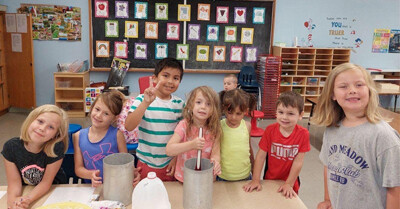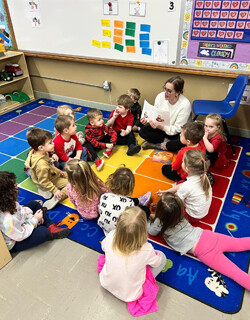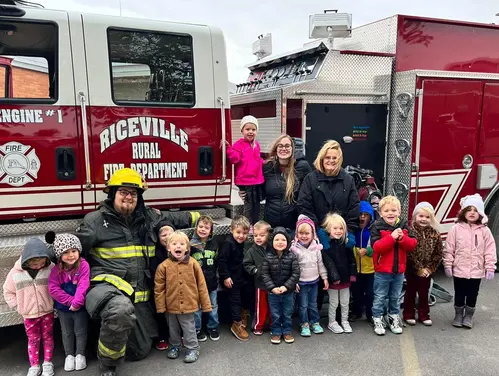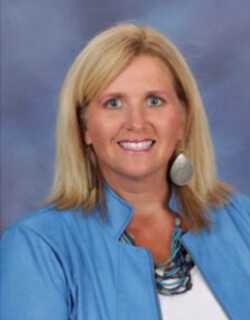Riceville Community School District has figured out some things about child care, and it’s working. It boils down to one simple three-letter word. Y-E-S.
Superintendent Barb Schwamman describes their success this way, “We call it the culture of yes. Yes, we are going to do this and yes, we are going to be successful. You just have to figure it out and have the right people in place.”
And yes, she has helped the district figure out how to successfully offer exceptional child care in this rural, northeast Iowa community, population 800 strong and growing. Currently, the K-12 school building houses about 400 students, up to 40 preschoolers, and an impressive 67 young children in child care.
Schwamman is no stranger to meeting needs in the early childhood arena. Armed with early childhood and elementary degrees and an extensive teaching and child-care background, she served on numerous child-care boards, was a school principal who wrote Statewide Voluntary Preschool Program grants, oversaw five preschools, one of which included child care, and helped build a new child-care center in nearby Cresco.
Currently serving as superintendent of both Riceville and Osage, she serves on a steering committee looking to expand the child-care opportunities and increase collaborations with the Osage school, which has a new child-care building on the elementary school property.
Under previous leadership, the Riceville Community Daycare had been in the community for over 20 years and in the school for almost eight years as a private entity. But over a year ago, that entity determined it was no longer feasible to continue running the child-care business.

“Our school knew child care was important because it is an economic development tool,” Schwamman said. “Child care became vital to the district because if we want kids going to our school, starting in our child-care center and offering that service is important. We knew to keep our preschools alive and our school going we had to take over the child care piece. We had to work hard, learn and look at what was working and what wasn’t in the child care setting.”
The child-care center had only 33 children enrolled when the district took over and it wasn’t clear just how the bills would get paid those first couple months. But by securing grant funds, building up a savings account, rebranding to get the word out, and thinking more like a business with a collaborative model, the now solvent Little Cats Daycare landed squarely on its feet.
“There is so much that makes sense here,” Schwamman said. “It is instant collaboration and a natural fit with the Health and Human Services licensing requirements.”

With the school assuming child care operations, collaboration was key. They could revamp the handbook and share district resources, like the internet and phones. Preschool playgrounds that already meet stringent early childhood standards could be shared with the child-care center, as well as the use of multi-purpose gymnasiums. Food service also joins in the collaboration by providing meals and snacks paid by the district through state funds.
Sharing resources also extends to staff. The district helps pay the cost of a child-care director who runs the center, but as a district employee and part of a shared model, the director also acts as an early childhood liaison and helps with all the reporting for the Statewide Voluntary Preschool Program. Collaborative in every aspect, the child-care center functions under an advisory committee that presents four times a year to the larger school board.
Schwamman said they asked themselves, “How can we possibly do this?” It was one more thing and staff are already working to capacity, especially in small schools where people are wearing multiple hats. A different knowledge base was required, such as learning how the funding works. But even with those fiscal and regulatory parameters, Schwamman insists success is always about finding those right, passionate people.

With that mantra in mind and research indicating changes were needed to attract people in the current market, leadership placed a practical and fiscal priority on hiring an exceptional director, Brooke Watson, to staff the center. They also revamped the salary schedule to pay center employees a more livable wage, helping to attract people from other areas, critical to ensuring a rural Iowa child-care provider is successful.
“We are trying to get our child-care staff wages on par with paraeducator wages, who start at $15 an hour and receive single health insurance,” Schwamman said. “We have to offer top quality wages to attract a quality workforce because we are very isolated from other communities.
“The economic development piece is so important. People are not going to accept a job if they cannot find child care. If we need more families and folks in the workforce we need to provide quality child care where their child is safe, where there are assurances and quality standards in place.”

Other unconventional incentives include a director’s bonus check for every 10 children enrolled in child care and offering employees with good attendance an opportunity to earn additional pay. Having both a school and child care on site is also a bonus when trying to attract teachers.
“How awesome is it to bring your child with you to work with onsite child care?”, Schwamman said. “Someone who is having a baby this spring can bring their baby to work and walk down the hall to the child-care center and visit the baby, or for breastfeeding, or to just hold the baby for a while.”
With the school and child-care center sharing the same spaces, it is also efficient to share education and training opportunities.
“We are now doing PBIS in the elementary setting, so we try to implement and reinforce mutual language,” Schwamman said. “If we are going to do first aid and CPR training, the child-care staff can take part as well. We just did radon training in our building, and could absorb some of that cost to include the child-care center because it is in our building. It is a better, more efficient use of resources.”

Schwamman said they are also thinking about how to utilize people in multiple roles.
“We are working hard on recruiting our retired senior citizens,” Schwamman said. “At Osage we use the Foster Grandparent Program. At Riceville we have the Retired Senior Citizens Volunteer Program (RSVP) where senior citizens come in and read with elementary students.”
Schwamman and her staff are thinking about how to get seniors to come in on a weekly basis to help with babies in child care, how to tap into the elderly who may not have kids and grandkids who live close anymore, how to fill part-time positions with reliable people and how to access that multigenerational approach and help seniors stay connected to their community.
Innovative solutions for staffing the child-care center are not just relegated to the adult workforce. Riceville is also able to utilize students who may have a passion or interest in child care or education fields.
“We currently have three Riceville high schoolers who are certified paraeducators and are working on earning their teaching degrees, so we are growing our own. What a great thing for these students to have on their resumes,” Schwamman said.
Iowa law recently changed to allow more flexibility with students who can help work in the center. The district currently employs about eight students part-time who can come in at 6 a.m. and work until 8 a.m., or work into their first class period or two and receive work-based learning credit for those opportunities.
“That can be a difficult time of day to get other workers because they have small kids themselves or are getting kids off to school,” Schwamman said. “It’s a niche area that those students have helped us fill. Some students are involved in sports or music or other activities and are not available after school, but they are free in the mornings.”
The district received the Teacher and Paraeducator Registered Apprenticeship Program (TPRA) grant and hopes to work with Northeast Iowa Community College for students interested in pursuing a career in education to receive college credit for their work in child care.
Schwamman said the Riceville community has embraced the child-care model and the positive social, promotional public relations and community spirit the district receives is powerful.
“We have been helping a lot of schools around us who have strong child care but want to figure out how to get collaboration going with the district,” Schwamman said. “We have been seen as kind of an expert in this area.”

Riceville also draws in open enrolled families from surrounding communities where child-care centers may be full or there are no schools in town. Many families want their children to have a small town, small school experience close to home.
“We are continuing to develop. We cannot rest on our laurels,” Schwamman said. “Bottom line is we can look at the child-care center to look at our projections for enrollment and the future of our school. We are growing our own students this way.
“We see child care as a key to maintaining stable enrollment. If they start with us, hopefully they will stay with us. It’s about being a life-long learner, being creative and thinking outside the box. Traditional methodologies aren’t going to get us very far. We have to continue to evolve.”
And yes, the Riceville Community School District is making it happen.
Note from the director: Brooke Watson highlights benefits, successes of Little Cats Daycare
The school has welcomed Little Cats Daycare with open arms. We feel like a single unit. We are able to utilize the printers, fax machine, laminator, and copier. They help with school, art, and toiletry supplies. We share the same playgrounds. Our meals are provided by the school as well. Students love walking down the halls and seeing their little brother, sister, mom, or grandma in the same building.
Little Cats Daycare is able to utilize school staff to help our day-to-day operations because we are run by the school district. The secretaries, paraeducators, janitors and maintenance crew, kitchen staff, and business administrator are always great at helping and answering our questions.
Little Cats Daycare is not only helping families find child care so both parents are able to work outside of the home, but we also create job opportunities. It is a great benefit of the job to be able to bring your child(ren) to work with you.
We have many parents who work at hog barns, so to better suit their needs, we've started extending our hours of operation so these parents can get to work on time. We also allow flexible scheduling for parents whose work schedules may change from week to week.
We charge by the hour rather than setting a flat rate or having a minimum so you only pay for the hours your child is scheduled. This is a very unique benefit not many centers offer. We do our best to fit everyone's needs so we can serve our community to the best of our ability.
For anyone who’s questioning whether or not to collaborate your child-care center with the school, go for it. Jump in and give it 100 percent because you will not be disappointed. It takes a lot of work and planning, but in the long run, it will pay off for the families, child-care center, school, and community.
Director Brooke Watson, Little Cats Daycare, Riceville
Subscribe to receive email updates from the Iowa Department of Education.


